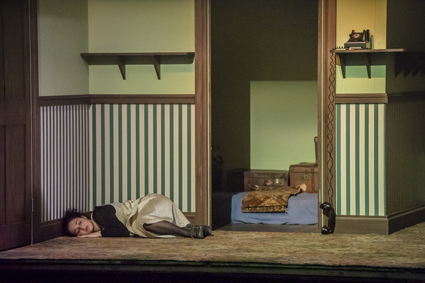lured to the horizon
jonathan bollen: brink productions, nicki bloom’s land & sea

Land & Sea, Brink Productions
photo Chris Herzfeld
Land & Sea, Brink Productions
THE PUBLICITY PHOTOGRAPH FOR BRINK PRODUCTIONS’ LAND AND SEA IS EVOCATIVE. THE LANDSCAPE IS UNMISTAKEABLY SOUTH AUSTRALIAN, JUST SOUTH OF ADELAIDE, I GUESS. THE DRY LAND FORM IS LOW, THE FLAT SEA IS SHALLOW, AND THE SKY IS BRIGHT WHITE-BLUE. IN THE FOREGROUND, A FIGURE IN PYJAMAS SITS IN A BATHTUB, HEAD TURNED TO THE HORIZON, AND ROWS WITH TREE BRANCHES AS OARS AS IF OUT TO SEA.
The composition of this photograph encodes the settler lifestyle of Australia. Between land and sky the sea intervenes as the past-and-future medium of arrival and departure. In other Australian plays, I have learnt to read this turning of the face to the horizon, to where sea and sky meet in the beyond, as a white man’s aspiration, a neo-spiritual gesture that would transcend the hard politics of the land.
A publicity photograph is not performance. In the flow of production, it is created early on. It announces an aesthetic impetus, but does not govern the direction. Yet visual meanings are associative, part of a chain of meanings that seep into the experience of stage action and set design. In Nicki Bloom’s new play there is a beach. A man is washed ashore. His face is washed and, in a ritual, whipped with wet branches from a tree. Later there is an imaginary bathtub. But the script never settles on the image. It is also quite elusive in signifying time and place.
Wendy Todd’s design for Land and Sea is beautifully conceived. The Queen’s Theatre is Adelaide’s oldest; its old walls and iron roof enclose a deep expanse of space. Our chairs are arranged half-way around a circle of pale sand enclosed in billowing white drapes. At first, the curtains remain drawn. We watch the first scene play out through diaphanous panels. These are removed, creating wave-like scallops, defining the edge of a circus ring space. Later the curtains are fully raised, and then the action partly transitions into a realistic box set.
Director Chris Drummond explains that he and Bloom share an interest in the contemporary theatre of German director Christoph Marthaler (see RT76, p8). The elusive play of time and place in Bloom’s script suits the post-dramatic. But this production also shares its tent-theatre aesthetic and Brechtian musicality with the legacy of the ‘new wave’ Sydney-style. Actors entering and exiting mid-way through the audience recalls the distinctive architecture of the Stables and Belvoir. There are stylistic echoes of the colonial plays of the 1970s, John Bell’s Shakespeares at Nimrod, Louis Nowra’s The Golden Age, Michael Gow’s Away and Neil Armfield’s production of Cloudstreet. The costuming is loose, unbuttoned, in the pale earth colours of the colony. Elemental props—a basket of eggs, a ukulele, cardboard signs, a bottle—are handled with simple theatricality.

Land & Sea, Brink Productions
photo Chris Herzfeld
Land & Sea, Brink Productions
The performers play character strings in related stories, starting with a settler scene where food is scarce and lighting is by hurricane lamp. Mr Greene (Rory Walker) sends his daughter Vera (Danielle Catanzariti) to gather eggs, and colludes with neighbour Essie (Jacqy Phillips) to inhibit Vera’s excitement when Poor Tom (Thomas Conroy) is washed up on the beach. Next the settler story translates into a family melodrama of displaced aristocracy and misrecognised relations with King Billy (Walker), Queen Esther (Phillips), Prince Tomason (Conroy) and his lost love Vera the True (Catanzariti). Later, in the present, the young lovers are homeless, strangers to each other, on the beach and cold—with only alcohol, Hawaiian melodies and their imaginations to keep them warm.
Music is omnipresent: medieval ostinatos, Christmas lullabies, an aria from Gluck’s Orfeo, French nursery rhymes, echoes of Dietrich and Satie. These snatches are delivered by the performers—Jacqy Phillips sings throaty cabaret in French, German and Russian—with Hilary Kleinig on cello, piano and sound effects. But this is ‘post-melodramatic’ theatre: the music doesn’t amplify the characters’ emotions; it heightens the performers’ contributions to scenography.
Beyond the sand-circle and white curtains, the box set is hidden with black flats. The reveal is somewhat clumsy. But the scene set in this house—with its 1930s furnishings, its dark wooden doors and window frames, its wartime speeches on the radio and a ringing telephone that delivers death—is the play’s most imaginative transportation. I enjoyed the lurch of this phase shift into a different space. I wanted to move with the production into the house—and then onto the land. But, in the spirit of circular completion, the performers are lured back onto the sand to gaze—beyond us, through us—to the horizon of sea and sky.
Brink Productions, Land & Sea, writer Nicki Bloom, director Chris Drummond, performers Rory Walker, Danielle Cantanzariti, Jacqy Phillips, Thomas Conroy, designer Wendy Todd, music director Hilary Kleinig, lighting designer Geoff Cobham, producer Kay Jamieson; Queen’s Theatre, Adelaide, May 12-26
RealTime issue #109 June-July 2012 pg. 25






